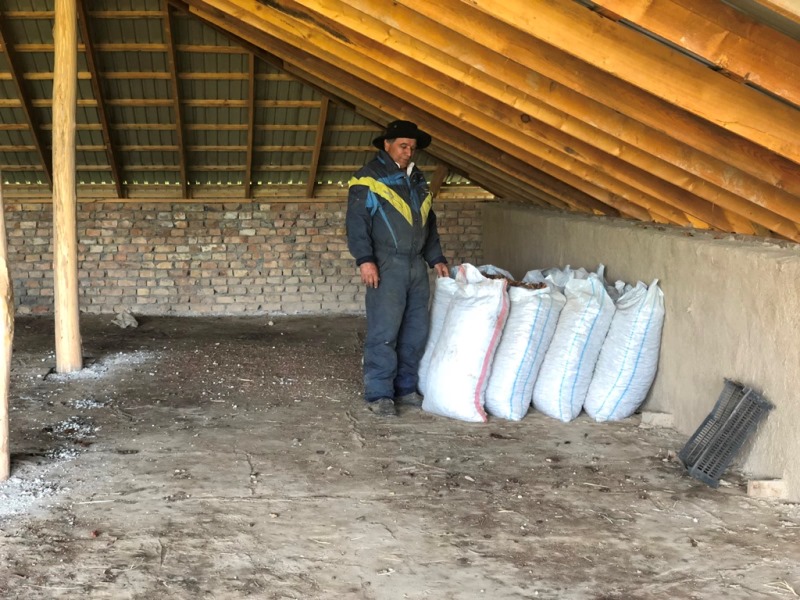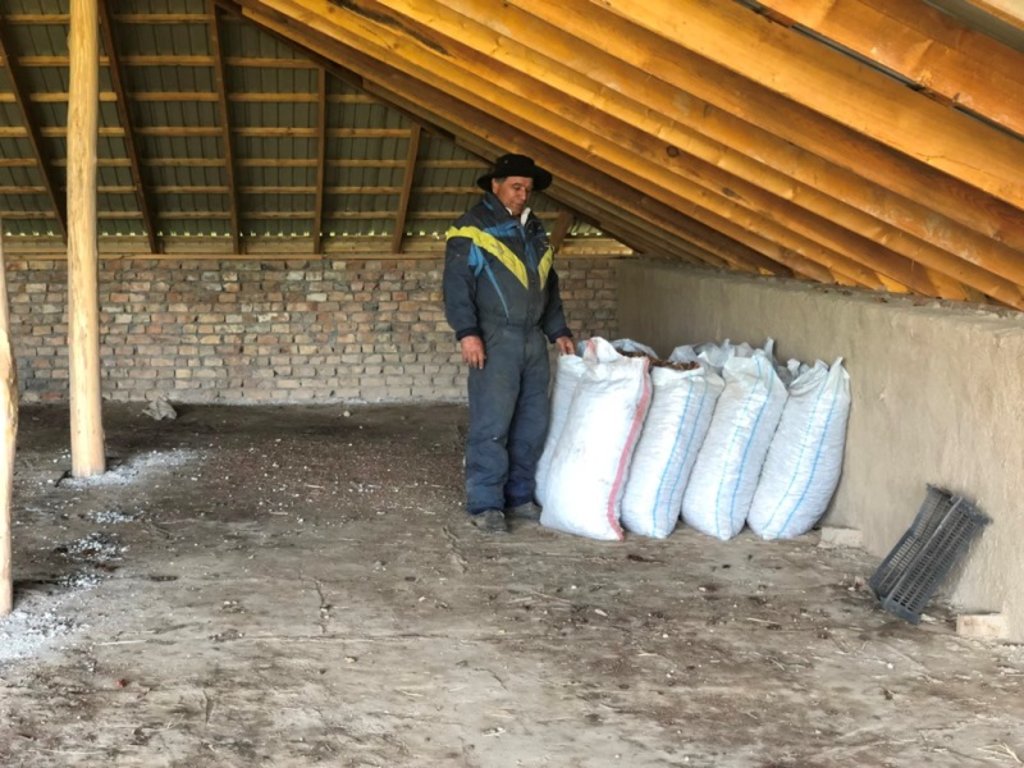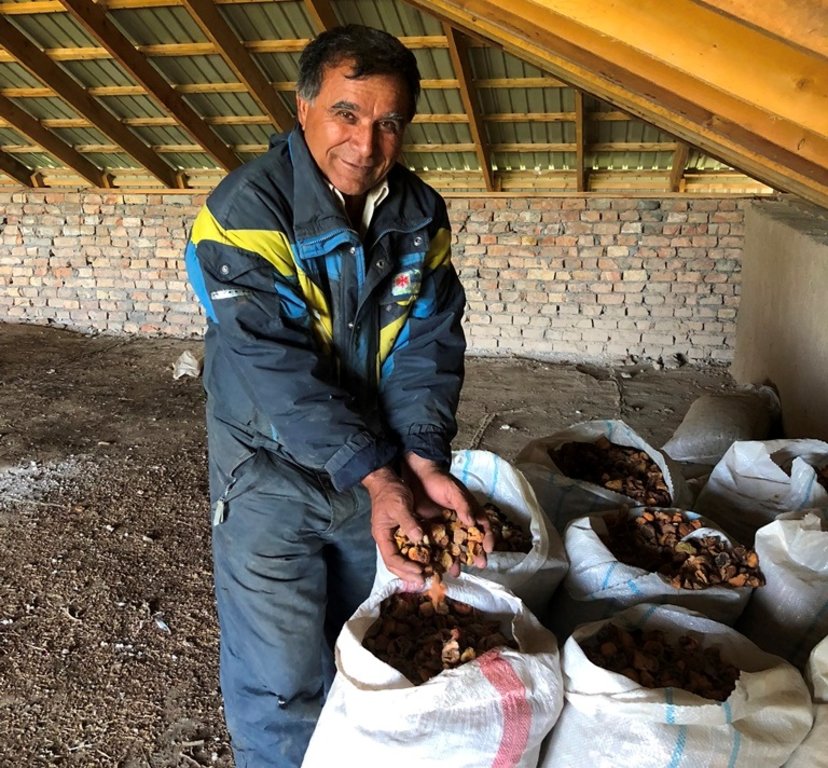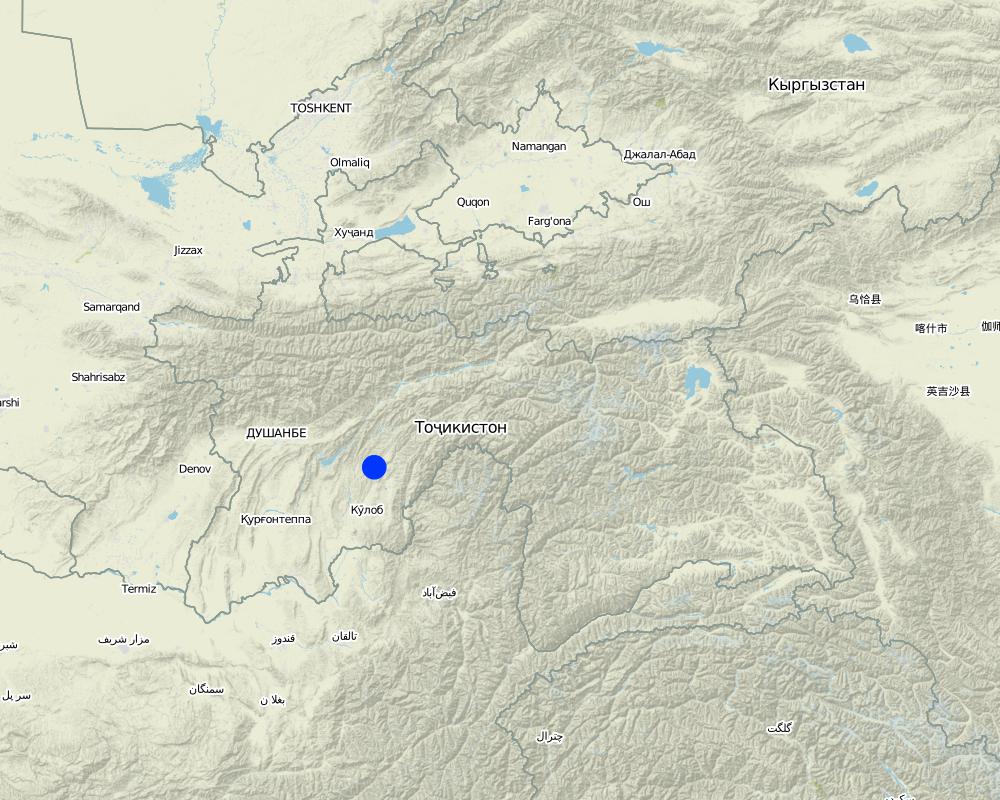Saving harvest of the orchards through drying [Tajikistan]
- Creation:
- Update:
- Compiler: Kamolidin Abdulloev
- Editor: –
- Reviewer: Farrukh Nazarmavloev
Пешгирии талафоти мева таввасути қоқкунӣ
approaches_3902 - Tajikistan
View sections
Expand all Collapse all1. General information
1.2 Contact details of resource persons and institutions involved in the assessment and documentation of the Approach
Name of project which facilitated the documentation/ evaluation of the Approach (if relevant)
Environmental Land Management and Rural Livelihoods (ELMAR)Name of the institution(s) which facilitated the documentation/ evaluation of the Approach (if relevant)
Committee for Environment Protection of Tajikistan (Committee for Environment Protection of Tajikistan) - Tajikistan1.3 Conditions regarding the use of data documented through WOCAT
When were the data compiled (in the field)?
02/06/2018
The compiler and key resource person(s) accept the conditions regarding the use of data documented through WOCAT:
Yes
2. Description of the SLM Approach
2.1 Short description of the Approach
Gardeners in different ways store apples, pears, pomegranates, grapes and nuts for winter, but the main part of the harvest used for the animals. Proposed approach help land users to save all the harvest using drying methods.
2.2 Detailed description of the Approach
Detailed description of the Approach:
People usually used fresh fruits and store it in a different way for the winter. Therefore, to preserve freshness and juiciness, apples and granates reserved them in jars.There are many opportunities for drying fruits in Safedshahrak village of Lohuti jamoat. The village has more than 10 hectares of orchards. The village is located far from the district center at a distance of 18 km, in the north-east part of the district and at an altitude of 1300 m. The climate is humid and with abundant rainfall. Local people are mainly engaged in growing potatoes, gardening and livestock breeding. Industrial enterprises do not function in the district. A small number of women study at Medical College and a vocational technical school or attend a special high and secondary schools in Dushanbe to get any skills. However, working places are only available in the central district hospital and general education schools for 5-6% of the total number of qualified women.
The project provides small-scale grants at the village level for groups of households to implement rural production and land management investments, as well as related small-scale infrastructure investments.Villages will prioritize investments based on a fixed budget for each type of rural investment, determined by the number of households
The CIG established in Safedshahrak village, which consisted of 25 members, and they recognize their work on drying fruits as an advantage in the first place. With the support of the project, the CIG was purchased and installed tools and equipment for drying fruit, and put production into operation.
Abdukodir Gozaev, a head of CIG, made all preparations for the construction of a warehouse for drying fruits, organized work on harvesting and drying fruit according to the plan. As a result, the rural people collected 60 tons of fresh fruit, which were dried. There are 3.5 tons of dried apples, 3.5 tons of cherries, 1 ton of rose hips and 0.5 tons of plums in the group's warehouse. Collected products were sold, and the sale profit was TJS 21950 (2,488$). The CIG head paid to the population from the funds received after the sale. In the future, he intends to prepare special boxes and sell them with packed dried fruit. This type of activity will give the opportunity to adapt their products to market requirements
2.3 Photos of the Approach
2.5 Country/ region/ locations where the Approach has been applied
Country:
Tajikistan
Region/ State/ Province:
Kulob Region, Khovaling District
Further specification of location:
Jamoat Lohuti, Safedshahrak village
Comments:
An approach was implemented in the Khovaling district, Lohuti jamoat, Safedshahrak village
Map
×2.6 Dates of initiation and termination of the Approach
Indicate year of initiation:
2016
Year of termination (if Approach is no longer applied):
2017
Comments:
An approach technical part done during the 2 month and after project monitored it, presently CIG is managing and maintaining
2.7 Type of Approach
- project/ programme based
2.8 Main aims/ objectives of the Approach
Supporting gardeners to improve the management of the orchards and to save their harvest using drying fruit approach, by this way to raise the household income
2.9 Conditions enabling or hindering implementation of the Technology/ Technologies applied under the Approach
social/ cultural/ religious norms and values
- enabling
People usually used fresh fruits or stored apples, pears, grapes and nuts for winter only as the juice and did not drying them. Duirng the season gardenners lost thousands tons of the fruits that were the main part of their harvest
As the result of the project there were appeared an opportunity to save all the harvest from their orchards and additionaly have income from that
availability/ access to financial resources and services
- enabling
Gardeners used only fresh fruits and did not use the main part of their harvest as a result, the rural people collected 60 tons of fresh fruit, which were dried. There are 3.5 tons of dried apples, 3.5 tons of cherries, 1 ton of rose hips and 0.5 tons of plums in the group's warehouse. Collected products were sold and have a good profit. The CIG head paid to the CIG Members (local Land Users) from the funds received after the sale. In the future, he intends to prepare special boxes and sell them with packed dried fruit. This type of activity will give the opportunity to adapt their products to market requirements.
institutional setting
- enabling
As the result of the project established the Common Interest Group that will manage and maintain the approach in future
knowledge about SLM, access to technical support
- hindering
Lack of knowledge on SLM approaches and technologies There was organised different type of SLM relative trainings on behalf of the project during the approach implementation
3. Participation and roles of stakeholders involved
3.1 Stakeholders involved in the Approach and their roles
- local land users/ local communities
Gardeners (CIG Members)
Local land users prioritized investments based on a fixed budget for each type of rural investment determined by the number of households. Within a plan of action, participants decided on the allocation of investments to groups of households using rules that limit the funding for any one household.
- SLM specialists/ agricultural advisers
Reprezentatives from the project parners and government institutions
Reprezentaives from the facilitating organisations and professors (as TOT trainers) from the Institutions and academies involved during the trainings
- local government
Hukumat and jamoat reprezentatives
Jamoat representatives were involved in Participatory Rural Appraisal (PRA) that was used as the main pre-assessment mechanism to analyze the socio-economic and environmental situation in the selected pilots, The RRC(Rayon Review Committee) will consider the combination of proposed sub-projects within the overall context of the rayon and project. The committee will review and accept proposals that meet project guidelines and provide clearance to the IG for the release of project funding to the accounts of relevant CIGs.
3.2 Involvement of local land users/ local communities in the different phases of the Approach
| Involvement of local land users/ local communities | Specify who was involved and describe activities | |
|---|---|---|
| planning | passive | Project beneficiaries (CIG Members) interviewed and consulted during the social assessment conducted in the project design process which then influenced project approaches. |
| implementation | interactive | During the Participatory and Community Action Planning Villagers (CIG Members) made grant allocation decisions. After the supporting CIGs proposals, they had managed grant funds and purchased needed materials and products individually |
| monitoring/ evaluation | passive | active participation of the local land users during the monitoring process |
3.3 Flow chart (if available)
3.4 Decision-making on the selection of SLM Technology/ Technologies
Specify who decided on the selection of the Technology/ Technologies to be implemented:
- mainly land users, supported by SLM specialists
Explain:
Local land users prioritized investments based on a fixed budget for each type of rural investment determined by the number of households. Within a plan of action, participants decided on the allocation of investments to groups of households using rules that limit the funding for any one household.
Specify on what basis decisions were made:
- evaluation of well-documented SLM knowledge (evidence-based decision-making)
- Project initial phases
4. Technical support, capacity building, and knowledge management
4.1 Capacity building/ training
Was training provided to land users/ other stakeholders?
Yes
Specify who was trained:
- land users
If relevant, specify gender, age, status, ethnicity, etc.
It was provided full participation of the male and female as it was a planned by project indicator
Form of training:
- on-the-job
- farmer-to-farmer
- public meetings
Subjects covered:
Financial management, reporting, subproject/approach management and technical, SLM reletive trainings
Comments:
Composting, mulching, managing salinization, intercropping on slopes, drip irrigation, low-cost watering techniques, solar greenhouses, drought-resistant crops, bee-keeping, mixed fruit orchards (planting, growing process, harvesting and marketing), local varieties nurseries, rotational grazing, Livestock breeding and maintaining, strategic watering points, use of perennial forage and marketing options (how to manage and prepare the harvest to the market) and opportunities was provided for the land user during the project implementation.
4.2 Advisory service
Do land users have access to an advisory service?
Yes
Specify whether advisory service is provided:
- on land users' fields
- at permanent centres
Describe/ comments:
Jamoat (agronomist, ecologist and other specialists) advise CIG Members
4.3 Institution strengthening (organizational development)
Have institutions been established or strengthened through the Approach?
- yes, a little
Specify the level(s) at which institutions have been strengthened or established:
- local
Describe institution, roles and responsibilities, members, etc.
The Common Interest Groups formed in the villages on behalf households and enhanced their knowledge. And the project provides small-scale grants at the village level for groups of households (CIG) to implement rural production and land management investments, as well as related small-scale infrastructure investments. Villages will prioritize investments based on a fixed budget for each type of rural investment, determined by the number of households.
Specify type of support:
- financial
- capacity building/ training
Give further details:
Project-financed grants to CIGs for each investment under categories of rural production and land management investments, as well as related small-scale infrastructure investments that will not exceed US$7,000 and will require a match of 25% in beneficiary contributions which may be in cash or in-kind
4.4 Monitoring and evaluation
Is monitoring and evaluation part of the Approach?
Yes
Comments:
environmental aspects, management of the investments, and other social and economic issues
If yes, is this documentation intended to be used for monitoring and evaluation?
Yes
Comments:
FOs build CIG capacities to monitor these aspects and to adapt to changing conditions.
4.5 Research
Was research part of the Approach?
No
5. Financing and external material support
5.1 Annual budget for the SLM component of the Approach
If precise annual budget is not known, indicate range:
- 2,000-10,000
Comments (e.g. main sources of funding/ major donors):
GEF/PPCR through WB
5.2 Financial/ material support provided to land users
Did land users receive financial/ material support for implementing the Technology/ Technologies?
Yes
If yes, specify type(s) of support, conditions, and provider(s):
The project financed investments in three categories that are expected to improve household assets and sustainable land management, and build climate resilience,
The CIGs prepared proposals for investments that included basic data on beneficiaries and funding requirements, the objectives and the issue/opportunity that is being addressed, description of the investment and activities (including a work plan and budget), summary of environmental, economic and social feasibility and sustainability measures, and a brief monitoring and evaluation plan.
Project financed grants to the CIGs that not exceed US$7,000 and will require a match of 25% in beneficiary contributions which may be in cash or in-kind. The grants disbursed in tranches directly to beneficiaries or groups to their own bank account
5.3 Subsidies for specific inputs (including labour)
- none
If labour by land users was a substantial input, was it:
- voluntary
Comments:
Land users contributed more then 25% for the total approach amount, and it was as an kind (local materials, labour). The CIG membes prepare building and reconstructed it for their project as it was community contribution.
5.4 Credit
Was credit provided under the Approach for SLM activities?
No
5.5 Other incentives or instruments
Were other incentives or instruments used to promote implementation of SLM Technologies?
Yes
If yes, specify:
Study tours, competition farmer to farmer
6. Impact analysis and concluding statements
6.1 Impacts of the Approach
Did the Approach empower local land users, improve stakeholder participation?
- No
- Yes, little
- Yes, moderately
- Yes, greatly
As a result, the rural people collected 60 tons of fresh fruit, which were dried. There are 3.5 tons of dried apples, 3.5 tons of cherries, 1 ton of rose hips and 0.5 tons of plums in the group's warehouse. Collected products were sold, in the local market. Local land users paid to their members from the funds received after the sale.
Did the Approach improve knowledge and capacities of land users to implement SLM?
- No
- Yes, little
- Yes, moderately
- Yes, greatly
A big bunch of the training and meetings had been organized with the CIG (local land users) that will give them an opportunity to manage and maintain on hand approach
During establishment of CIG, which consists of 25 people, members of the group, 9 of whom are married women, and they recognize their work on drying fruits as an advantage in the first place.
In the future, the local land users intends to prepare special boxes and sell them with packed dried fruit. This type of activity will give the opportunity to adapt their products to market requirements.
The project gives CIG members a ery good opportunity not only to save their harvest but have not bad income from this. I the future the CIG mambers planned to think about the marketing issues packaging dried fruits and adapt it to the market requirementsand find more profit.
6.2 Main motivation of land users to implement SLM
- increased production
As a result, the rural people collected 60 tons of fresh fruit, which were dried. There are 3.5 tons of dried apples, 3.5 tons of cherries, 1 ton of rose hips and 0.5 tons of plums in the group's warehouse.
- enhanced SLM knowledge and skills
The local land users (CIG Members) participated in SLM training
6.3 Sustainability of Approach activities
Can the land users sustain what has been implemented through the Approach (without external support)?
- yes
If yes, describe how:
The local land user from the beginning did all the activities individually after the training that was provided by the project. made grant allocation decisions, also CIGs managed grant funds and bought inputs. Maintaining actions are in place
6.4 Strengths/ advantages of the Approach
| Strengths/ advantages/ opportunities in the land user’s view |
|---|
| The head of CIG is the specialist and knows all the details of the activity that help them better manage and maitain an approach |
| The building and the local materials that was used during the project belonged to the CIG members and it gives them opportunity to implement such project |
| Strengths/ advantages/ opportunities in the compiler’s or other key resource person’s view |
|---|
| Being in a group(CIG), gives opportunity to do desicions together and expanding approach in the plan |
| Capacity building events that was organised during the approach, new technologies, new knowledges and so on |
| Good cooperation with the jamoat |
6.5 Weaknesses/ disadvantages of the Approach and ways of overcoming them
| Weaknesses/ disadvantages/ risks in the compiler’s or other key resource person’s view | How can they be overcome? |
|---|---|
| Market, value chance, preparation of the business plans and other reletive knowledges they need | Other coming projects or local hukumat needs to support them |
7. References and links
7.1 Methods/ sources of information
- interviews with land users
Local land users (CIG Members)
- interviews with SLM specialists/ experts
ELMARL Specialists
- compilation from reports and other existing documentation
Project progress reports and other documents
7.2 References to available publications
Title, author, year, ISBN:
ELMARL Annual Report 2017
7.3 Links to relevant information which is available online
Title/ description:
Knowledge Management platform on SLM
URL:
https://slmtj.net
Links and modules
Expand all Collapse allLinks
No links
Modules
No modules






